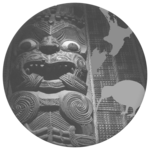| Music of New Zealand | ||||||||
| General topics | ||||||||
|---|---|---|---|---|---|---|---|---|
| Genres | ||||||||
|
||||||||
| Specific forms | ||||||||
|
||||||||
| Media and performance | ||||||||
|
||||||||
| Nationalistic and patriotic songs | ||||||||
|
||||||||
| Part of a series on the |
| Culture of New Zealand |
|---|
 |
The music of New Zealand has been influenced by a number of traditions, including Māori music, the music introduced by European settlers during the nineteenth century, and a variety of styles imported during the twentieth century, including blues, jazz, country, rock and roll, reggae, and hip hop, with many of these genres given a unique New Zealand interpretation.[1][2]
Pre-colonial Māori music consisted mainly of a form of microtonal chanting and performances on instruments called taonga pūoro: a variety of blown, struck and twirled instruments made out of hollowed-out wood, stone, whale ivory, albatross bone, and human bone. In the nineteenth century, European settlers - the vast majority of whom were from Britain and Ireland - brought musical forms to New Zealand including brass bands and choral music, and musicians began touring New Zealand in the 1860s.[3][4] Pipe bands became widespread during the early 20th century.[5]
In recent decades, a number of popular artists have gone on to achieve international success including Lorde,[6] Split Enz, Crowded House, Rosé, OMC, Bic Runga, Benee, Kimbra, Ladyhawke, The Naked and Famous, Fat Freddy's Drop, Savage, Gin Wigmore, Keith Urban, Flight of the Conchords, Brooke Fraser and Alien Weaponry.
New Zealand has a national orchestra, the New Zealand Symphony Orchestra, and many regional orchestras. A number of New Zealand composers have developed international reputations. The best-known include Douglas Lilburn,[7] John Psathas,[8] Jack Body,[9] Gillian Whitehead,[10] Jenny McLeod,[11] Gareth Farr,[12] and Ross Harris.[13]
- ^ Swarbrick, Nancy (June 2010). "Creative life – Music". Te Ara – the Encyclopedia of New Zealand. Archived from the original on 14 May 2011. Retrieved 21 January 2011.
- ^ Southgate, William (September 1977). "Current Developments in New Zealand music". Composers Association of New Zealand Newsletter: 25–27.
- ^ McLintock, Alexander, ed. (April 2009) [originally published in 1966]. "Music: General History". from An Encyclopaedia of New Zealand. Te Ara – the Encyclopedia of New Zealand. Archived from the original on 30 April 2011. Retrieved 15 February 2011.
- ^ McLintock, Alexander, ed. (April 2009) [originally published in 1966]. "Music: Brass Bands". from An Encyclopaedia of New Zealand. Te Ara – the Encyclopedia of New Zealand. Archived from the original on 16 May 2011. Retrieved 14 April 2011.
- ^ McLintock, Alexander, ed. (April 2009) [originally published in 1966]. "Music: Pipe Bands". from An Encyclopaedia of New Zealand. Te Ara – the Encyclopedia of New Zealand. Archived from the original on 16 May 2011. Retrieved 14 April 2011.
- ^ "Lorde's 'Royals' Reigns on Hot 100 for Eighth Week". Billboard. Archived from the original on 30 March 2014. Retrieved 3 February 2014.
- ^ "Story: Lilburn, Douglas Gordon". Archived from the original on 8 June 2020. Retrieved 3 February 2014.
- ^ "John Psathas composer profile". Archived from the original on 6 January 2009. Retrieved 3 February 2014.
- ^ "Jack Body composer profile". Archived from the original on 2 May 2017. Retrieved 3 February 2014.
- ^ "Gillian Whitehead composer profile". Archived from the original on 8 June 2017. Retrieved 3 February 2014.
- ^ "Jenny McLeod composer profile". Archived from the original on 21 September 2014. Retrieved 3 February 2014.
- ^ "Gareth Farr composer profile". Archived from the original on 28 April 2017. Retrieved 3 February 2014.
- ^ "Ross Harris composer profile". Archived from the original on 13 July 2014. Retrieved 3 February 2014.
